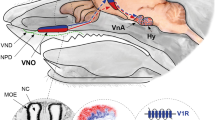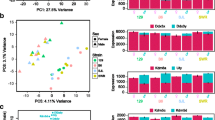Abstract
Pheromones elicit specific behavioural responses and physiological alterations in recipients of the same species1. In mammals, these chemical signals are recognized within the nasal cavity by sensory neurons that express pheromone receptors. In rodents, these receptors are thought to be represented by two large multigene families, comprising the V1r and V2r genes, which encode seven-transmembrane proteins2,3,4,5. Although pheromonal effects have been demonstrated in humans6, V1R or V2R counterparts of the rodent genes have yet to be characterized.


Similar content being viewed by others
References
Karlson, P. & Lüscher, M. Nature 183, 55–56 (1959).
Dulac, C. & Axel, R. Cell 83, 195 –206 (1995).
Herrada, G. & Dulac, C. Cell 90, 763 –773 (1997).
Matsunami, H. & Buck, L.B. Cell 90, 775 –784 (1997).
Ryba, N.J. & Tirindelli, R. Neuron 19, 371–379 (1997).
Stern, K. & McClintock, M.K. Nature 392, 177–179 (1998).
Saito, H., Mimmack, M.L., Keverne, E.B., Kishimoto, J. & Emson, P.C. Mol. Brain Res. 60, 215–227 (1998).
Mombaerts, P. Curr. Opin. Genet. Dev. 9, 315–320 (1999).
Rodriguez, I., Feinstein, P. & Mombaerts, P. Cell 97, 199– 208 (1999).
Keverne, E.B. Science 286, 716–720 ( 1999).
Humphrey, T. J. Comp. Neurol. 73, 431–468 (1940).
Stensaas, L.J., Lavker, R.M., Monti-Bloch, L., Grosser, B.I. & Berliner, D.L. J. Steroid Biochem. Mol. Biol. 39, 553–560 ( 1991).
Johnston, R.E. in Olfaction and Taste XII. An International Symposium (ed. Murphy, C.) 333–348 (New York Academy of Sciences, New York, 1998).
Hudson, R. & Distel, H. Physiol. Behav. 37, 123–128 (1986).
Dorries, K.M., Adkins-Regan, E. & Halpern, B.P. Brain Behav. Evol. 49, 53– 62 (1997).
Acknowledgements
We thank J. Yee for technical assistance; D. Ross for assistance in obtaining biopsies of human olfactory mucosa; and T. Bozza, P. Feinstein, L. Stryer, T. Perry and P. Vassalli for critical review. I.R. was supported by postdoctoral fellowships from the Swiss National Science Foundation, the European Molecular Biology Organization, and the Human Frontier Science Program. Grant support to C.A.G. and P.M. was from the National Institutes of Health, and to P.M. from the March of Dimes Birth Defects Foundation and Senomyx.
Author information
Authors and Affiliations
Corresponding author
Rights and permissions
About this article
Cite this article
Rodriguez, I., Greer, C., Mok, M. et al. A putative pheromone receptor gene expressed in human olfactory mucosa . Nat Genet 26, 18–19 (2000). https://doi.org/10.1038/79124
Issue Date:
DOI: https://doi.org/10.1038/79124
- Springer Nature America, Inc.
This article is cited by
-
From odor to oncology: non-canonical odorant receptors in cancer
Oncogene (2024)
-
Current Theories in Odorant Binding
Current Otorhinolaryngology Reports (2022)
-
De-Scent with Modification: More Evidence and Caution Needed to Assess Whether the Loss of a Pheromone Signaling Protein Permitted the Evolution of Same-Sex Sexual Behavior in Primates
Archives of Sexual Behavior (2021)
-
Coding of pheromones by vomeronasal receptors
Cell and Tissue Research (2021)
-
Structural, morphometric and immunohistochemical study of the rabbit accessory olfactory bulb
Brain Structure and Function (2020)





